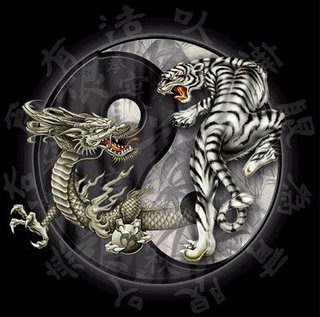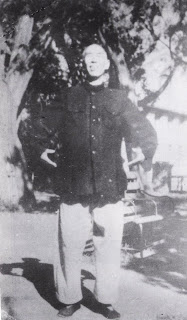the origins (last part)
In the xinyi school, wich was at the origins of the yiquan, the method used to link the inside and the outside was represented by the six harmonies (or six coordinations / Liuhe) theory. But there is another chinese boxing school that uses this notion as its basis : the liuhebafaquan, also called xinyi from the Yue mount, in reference to its geographical origin.
One of the best specialist of this boxing was the master Wu yihui, whom Wang xiangzhai met in Shanghai and whom he was a great admirator of. Some of the very first disciples of Wang xiangzhai even became disciples in this school as well, like Zhang changxin and Han xingqiao.
Those six harmonies are divided in three internal harmonies and three external harmonies. The heart (xin) leads the intention (yi) that leads the energie (qi) wich one leads the force (li), constituting thus three internal harmonies.
About the three external harmonies, they are often said to be wrists-ankles, elbows-knees and shoulders-hips. But this theory, then, doesn't help the practicionner in his achievement, according to the fact that any movment can only be the result of a good coordination between those body segments.
Now, as we did already see in the first part of this article, according to the different exercices like the xinyiliuhe's "squatting the monkey" stance and the xingyi's three wholes stance, wich are the ancestor of yiquan's stances, we can explain this theory in another way :
The "three curves" wich are mentioned in the old xinyiliuhe would be three major articulations of the whole body, the same that link the "three whole" (santi) of the xingyiquan. Those three curves would be the articulation of the hips (lumbar curve), the articulation of the back (dorsal curve) and the sternal articulation (sternum-shoulder curve). A right coordination between those three curves allows an effective use of the deep muscles, wich are close to the spinal column...

These three articulations are used to generate a natural force in the six directions : up-down, forward-backward and closing-opening. Those six directions were technically represented, in the old xinyi, by the three old fists : Zuan (piercing), guo (wrapping) and jian (stepping in). Wang xiangzhai talks about it in his first book and says that those three forces must be mixed together.
Besides the six harmonies, considered as the "method" of achievement in the xinyi and xingyi boxing, Wang xiangzhai's teaching was also based on the yin and yang theory.
The name of the stances known as "to lean on the tiger" (fuhuzhuang) and "to ride the dragon" (xianglongzhuang) are coming from taoist esoteric expressions.
In the chinese tradition, tiger and dragon are the representations of yin and yang energies. The dragon is mythical, he represents imagination and fabulous, he is flying in the air and in the water, he evokes the sky. His force is subtle, it is pure yang. The tiger is a real and concrete animal, his territoty is the land, he evokes the ground. Simple and direct, his force is natural and brutal, it is pure yin.
For the man, yang represents his spiritual developpment and yin represents his lower and primal instincts. "To lean on the tiger" (fuhu) in order to control him shows the idea of controling our lowest instincts. "To ride the dragon" (xianglong) shows the idea of spiritual developpment.
The two stances allow to developp martial capacitates attributed to the yin and yang : direct and powerfull force for the tiger, flexible and adaptable for the dragon's one.

Wang xiangzhai did developp those two "vitalities" at the beginning of his teaching in the 20's. He was, then, talking about two energies wich are the tiger's and the dragon's one...
One of the best specialist of this boxing was the master Wu yihui, whom Wang xiangzhai met in Shanghai and whom he was a great admirator of. Some of the very first disciples of Wang xiangzhai even became disciples in this school as well, like Zhang changxin and Han xingqiao.
Zhang changxin in a liuhebafa form, this boxing is also called "water boxing"
Those six harmonies are divided in three internal harmonies and three external harmonies. The heart (xin) leads the intention (yi) that leads the energie (qi) wich one leads the force (li), constituting thus three internal harmonies.
About the three external harmonies, they are often said to be wrists-ankles, elbows-knees and shoulders-hips. But this theory, then, doesn't help the practicionner in his achievement, according to the fact that any movment can only be the result of a good coordination between those body segments.
Now, as we did already see in the first part of this article, according to the different exercices like the xinyiliuhe's "squatting the monkey" stance and the xingyi's three wholes stance, wich are the ancestor of yiquan's stances, we can explain this theory in another way :
The "three curves" wich are mentioned in the old xinyiliuhe would be three major articulations of the whole body, the same that link the "three whole" (santi) of the xingyiquan. Those three curves would be the articulation of the hips (lumbar curve), the articulation of the back (dorsal curve) and the sternal articulation (sternum-shoulder curve). A right coordination between those three curves allows an effective use of the deep muscles, wich are close to the spinal column...

Tiger and dragon representing the yin and yang
These three articulations are used to generate a natural force in the six directions : up-down, forward-backward and closing-opening. Those six directions were technically represented, in the old xinyi, by the three old fists : Zuan (piercing), guo (wrapping) and jian (stepping in). Wang xiangzhai talks about it in his first book and says that those three forces must be mixed together.
Besides the six harmonies, considered as the "method" of achievement in the xinyi and xingyi boxing, Wang xiangzhai's teaching was also based on the yin and yang theory.
The name of the stances known as "to lean on the tiger" (fuhuzhuang) and "to ride the dragon" (xianglongzhuang) are coming from taoist esoteric expressions.
In the chinese tradition, tiger and dragon are the representations of yin and yang energies. The dragon is mythical, he represents imagination and fabulous, he is flying in the air and in the water, he evokes the sky. His force is subtle, it is pure yang. The tiger is a real and concrete animal, his territoty is the land, he evokes the ground. Simple and direct, his force is natural and brutal, it is pure yin.
For the man, yang represents his spiritual developpment and yin represents his lower and primal instincts. "To lean on the tiger" (fuhu) in order to control him shows the idea of controling our lowest instincts. "To ride the dragon" (xianglong) shows the idea of spiritual developpment.

Fuhuzhuang by master li jianyu
The two stances allow to developp martial capacitates attributed to the yin and yang : direct and powerfull force for the tiger, flexible and adaptable for the dragon's one.

Xianglongzhuang by master Li jianyu
Wang xiangzhai did developp those two "vitalities" at the beginning of his teaching in the 20's. He was, then, talking about two energies wich are the tiger's and the dragon's one...
